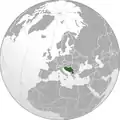Egypt–Yugoslavia relations
Egypt–Yugoslavia relations were historical foreign relations between Egypt (both Kingdom of Egypt 1922–1953 and post-revolutionary Republic of Egypt/United Arab Republic) and now break-up Yugoslavia (Kingdom of Yugoslavia 1918-1941 and Socialist Federal Republic of Yugoslavia 1945-1992). Both countries were founding members and prominent participants of the Non-aligned Movement. Belgrade hosted the movement's first conference for which preparatory meeting took place in Cairo, while Cairo hosted the second conference. While critical of certain aspects of the Camp David Accords Yugoslavia remained major advocate for Egyptian realist approach within the movement, and strongly opposed harsh criticism of Cairo or proposals which questioned country's place within the movement.
Egypt |
Yugoslavia |
|---|---|


History
World War II
On September 28, 1943, the Yugoslav government-in-exile was transferred to Egypt where it stayed until 1944.[1]
During the final stage of the World War II some 30,000 Yugoslav refugees from the German occupied Dalmatia found shelter in the Egyptian desert in the camp El Shatt.[2] Camp in El Shatt was one of the first long-lasting effort in state-building by the Yugoslav Partisans (following short episodes with Republic of Užice and Bihać Republic).[2] There they established institutions such as schools, newspapers, as well as new gender and labor relations and used the opportunity to develop their relations with the western Allies of World War II.[2]
Cold War history
.jpg.webp)
.jpg.webp)
It is believed that in 1954 Egypt supported Yugoslav efforts to initiate its military assistance to the National Liberation Front of Algeria by nominally purchasing Yugoslav weapons which was then transferred to Algeria.[3] Together with India, Egypt and Yugoslavia played crucial role in the establishment of the Non-Aligned Movement. Meeting between Yugoslav President Josip Broz Tito, Indian Prime Minister Jawaharlal Nehru and President of Egypt Gamal Abdel Nasser took place on the Brijuni Islands in the Yugoslav constituent Socialist Republic of Croatia on 19 July 1956.[4] Three leaders signed a document expressing that: "Peace cannot be achieved via division, but via striving for collective security on the global scale. Achieved by the expansion of the area of freedom, as well as through the ending of domination of one country over another."[4]
Yugoslav People's Army was one of 11 national armies which contributed to the United Nations Emergency Force following the 1956 Suez Crisis. In 1957 there was approximately 700 Yugoslav soldiers in the mission.[5] Between 1956 and 1967 total number of Yugoslav soldiers in Sinai reached 14.265.[6]
List of bilateral state visits

Yugoslav visits to Egypt
- 5 February 1955: Josip Broz Tito[6]
- 24 December 1955-6 January 1956: Josip Broz Tito[6]
- 5 December 1958: Josip Broz Tito[6]
- 20-28 February 1959: Josip Broz Tito[6]
- 17-22 April 1961: Josip Broz Tito[6]
- 18-19 November 1961: Josip Broz Tito[6]
- 4-14 February 1962: Josip Broz Tito[6]
- 18-21 February 1962: Josip Broz Tito[6]
- 5-10 October 1964: Josip Broz Tito[6]
- 15-24 April 1965: Josip Broz Tito[6]
- 2-7 May 1966: Josip Broz Tito[6]
- 8 February 1968: Josip Broz Tito[6]
- 23-25 February 1970: Josip Broz Tito[6]
- 13-20 February 1971: Josip Broz Tito[6]
- 20-21 October 1971: Josip Broz Tito[6]
- 20-27 January 1977: Josip Broz Tito[6]
Egyptian visits to Yugoslavia
- 12-19 July 1956: Gamal Abdel Nasser[6]
- 2-15 July 1958: Gamal Abdel Nasser[6]
- 12 November 1959: Abdel Hakim Amer[6]
- 12-20 June 1960: Gamal Abdel Nasser[6]
- July 1962: Gamal Abdel Nasser[6]
- 12-16 May 1963: Gamal Abdel Nasser[6]
- 1-4 September 1965: Gamal Abdel Nasser[6]
- 10-12 July 1968: Gamal Abdel Nasser[6]
- 3-4 February 1972: Anwar Sadat[6]
- 11-12 January 1973: Anwar Sadat[6]
- 28-30-?-1974: Anwar Sadat[6]
- 29-30 May 1975: Anwar Sadat[6]
- 8-10 April 1976: Anwar Sadat[6]
- November 1977: Anwar Sadat[6]
See also
Further reading
References
- "A Guide to the United States' History of Recognition, Diplomatic, and Consular Relations, by Country, since 1776: Kingdom of Serbia/Yugoslavia". Foreign Service Institute. Retrieved 28 October 2020.
- Bieber, Florian (2020). "Building Yugoslavia in the Sand? Dalmatian Refugees in Egypt, 1944–1946". Slavic Review. 79 (2): 298–322. doi:10.1017/slr.2020.85. Retrieved 28 October 2020.
- Tot, Dora (2018). Odnosi Jugoslavie I Alžira U Prvoj Polovici 1960-IH: Strategija Izgradnje Meke Moći (PDF) (Master Thesis). University of Zagreb.
- Krajcar, Dražem. "Tito, Nehru i Naser na Brijunima dogovorili osnivanje Pokreta nesvrstanih – 1956". Povijest.hr.
- Laznibat, Velimir (1957). "Pod zastavom OUN u Egipat". Naše More: Znanstveni časopis za more i pomorstvo (in Serbo-Croatian). 4 (1): 22–23. Retrieved 28 October 2020.
- R. Radonić, Nemanja (2020). Слика Африке у Југославији (1945-1991) (PDF) (Doctoral Thesis). University of Belgrade. Retrieved 1 November 2020.
.svg.png.webp)
